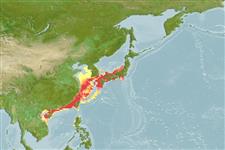>
Eupercaria/misc (Various families in series Eupercaria) >
Haemulidae (Grunts) > Plectorhinchinae
Etymology: Parapristipoma: Greek, para = the side of + Greek, pristis = saw + Greek, poma = operculum (Ref. 45335).
Environment: milieu / climate zone / depth range / distribution range
Écologie
marin benthopélagique; océanodrome. Subtropical; 39°N - 15°N, 105°E - 140°E
Indo-West Pacific: southern Japan, East China Sea and Taiwan.
Length at first maturity / Taille / Poids / Âge
Maturity: Lm 18.0, range 16 - 20 cm
Max length : 40.0 cm SL mâle / non sexé; (Ref. 559); poids max. publié: 1.1 kg (Ref. 40637)
Cultured and released for fishery in Japan. The species prefers relative warm water, high salinity, and rocky shores. The species does seasonal offshore-inshore migrations in limited areas (Ref. 34104).
Oviparous, distinct pairing during breeding (Ref. 205). A couple ascends quickly to the surface and spawns (Ref. 34104).
Masuda, H., K. Amaoka, C. Araga, T. Uyeno and T. Yoshino, 1984. The fishes of the Japanese Archipelago. Vol. 1. Tokai University Press, Tokyo, Japan. 437 p. (text). (Ref. 559)
Statut dans la liste rouge de l'IUCN (Ref. 130435: Version 2024-1)
Menace pour l'homme
Harmless
Utilisations par l'homme
Pêcheries: commercial; pêche sportive: oui
Outils
Articles particuliers
Télécharger en XML
Sources Internet
Estimates based on models
Preferred temperature (Ref.
123201): 18.2 - 26.6, mean 24.1 °C (based on 168 cells).
Phylogenetic diversity index (Ref.
82804): PD
50 = 0.5625 [Uniqueness, from 0.5 = low to 2.0 = high].
Bayesian length-weight: a=0.00933 (0.00558 - 0.01561), b=3.01 (2.86 - 3.16), in cm total length, based on LWR estimates for this species & (Sub)family-body (Ref.
93245).
Niveau trophique (Ref.
69278): 3.4 ±0.45 se; based on food items.
Résilience (Ref.
120179): Milieu, temps minimum de doublement de population : 1,4 à 4,4 années (K=0.25-0.35; tm=2; Fec=30,083).
Fishing Vulnerability (Ref.
59153): Moderate vulnerability (36 of 100).
Nutrients (Ref.
124155): Calcium = 63.2 [13.8, 129.8] mg/100g; Iron = 0.987 [0.507, 1.843] mg/100g; Protein = 18.4 [16.5, 20.2] %; Omega3 = 0.33 [0.16, 0.59] g/100g; Selenium = 27.9 [14.4, 54.5] μg/100g; VitaminA = 28.1 [10.6, 75.8] μg/100g; Zinc = 0.795 [0.567, 1.126] mg/100g (wet weight);
